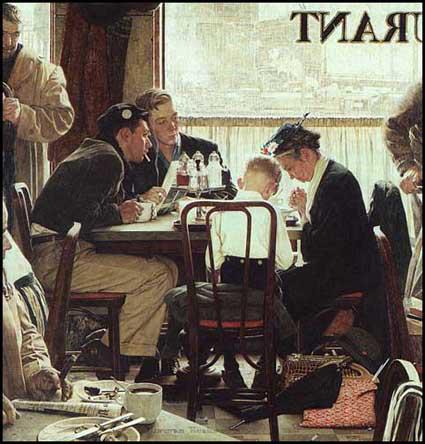Saturday Evening Post
The first edition of the Saturday Evening Post was published by Atkinson & Alexander on 4th August, 1821. Initially it was four page newspaper with no illustrations. Although the owners described it as a newspaper, the editor promised that all "political controversy" would not be avoided.
In 1839, George Rex Graham was employed as editor of the Saturday Evening Post. With the help of Charles J. Peterson, Graham turned it into one of the country's most interesting papers. It now advertised itself as "A Family Newspaper, Neutral in Politics, Devoted to Morality, Pure Literature, Foreign and Domestic News, Agriculture, the Commercial Interests, Science, Art, and Amusement". By 1855 the Saturday Evening Post had a circulation of 90,000.
By the late 1890s the Saturday Evening Post was in serious financial difficulties. In October, 1897, the newspaper was purchased for $1,000 by Cyrus H. Curtis, the owner of the Ladies' Home Journal. The Saturday Evening Post was redesigned and on January, 1898, reappeared as a journal. Emphasis was placed on three topics: business, public affairs and romance. Great care was taken with illustrations and they now appeared on every page of the journal.
In 1899 Curtis hired George Horace Lorimer as literary editor. Curtis was so impressed with Lorimer that within a few months he had become editor-in-chief. Curtis gave Lorimer total control over running the Saturday Evening Post. On one occasion Curtis told Lorimer that his wife did not like like an article that was in the journal. Lorimer replied that "I'm not editing the Post for your wife." Curtis made no further comment and soon afterwards increased Lorimer's salary to $250 a week.
Lorimer commissioned top journalist such as Frank Norris, David Graham Phillips, Willa Cather, Jack London, and William Stead to write articles for the journal. In 1903 the Saturday Evening Post spent $700 for the rights to publish London's Call of the Wild. Other writers whose stories appeared at this time included Rudyard Kipling, Theodore Dreiser, Sinclair Lewis, G. K. Chesteron, H. G. Wells, Arnold Bennett, John Galsworthy, Gilbert Parker and Stephen Crane.
George Horace Lorimer held conservative views and this was reflected in the articles he published in the magazine. Upton Sinclair wrote that the material in the Saturday Evening Post was as "standardized as soda crackers; originality is taboo, new ideas are treason, social sympathy a crime, and the one virtue of man is to produce larger and larger quantities of material things." However, Lorimer did employ the radical David Graham Phillips, who wrote over fifty articles criticizing the rich and power.
By December, 1908, Lorimer was able to announce in the Saturday Evening Post that for the first time the journal was selling over a million copies a week. Under Lorimer's stewardship circulation continued to increase and by the end of 1913 had reached 2,000,000.
In March 1916 Lorimer agreed to meet Norman Rockwell, a 22 year old artist from New York. When Lorimer saw his work he immediately accepted two front covers he had produced and commissioned three more. This was the start of his long-term relationship with the magazine that was to last over 45 years. Other illustrators who produced front covers during this period included Joseph Leyendecker, Charles Marion Russell and Walter Everett.
The Saturday Evening Post continued to grow in size. On 22nd November, 1919, the first 200 page issue came out. This included 111 pages of advertising, a third of which was for the car industry. Sales also increased and by the 1937 had reached 3,000,000.
When President Franklin Roosevelt made his 1941 address to Congress setting out the "four essential human freedoms" Rockwell decided to paint images of those freedoms for the Saturday Evening Post. These paintings were finished and published in 1943. The paintings portrayed Freedom of Worship, Freedom of Speech, Freedom of Want and Freedom from Fear. These pictures became extremely popular and reprints of the covers were sold in vast quantities.
During the Second World War the federal government decided to take the original paintings of the Four Essential Human Freedoms on a national tour to help sell war bonds. Over the next few weeks the paintings were seen by 1,222,000 people and were instrumental in selling $132,992,539 worth of bonds.

In 1947 it was estimated that each copy of the Saturday Evening Post was costing thirty cents to produce. This was double the cost of its cover price. Advertising revenue was therefore essential to its economic survival.
Norman Rockwell had the last of his 317 covers for Saturday Evening Post in December, 1963, when the magazine decided to abandon paintings on its front cover. This attempt to update its image was not successful in significantly increasing circulation or advertising revenue and the journal ceased publication in February, 1969.
